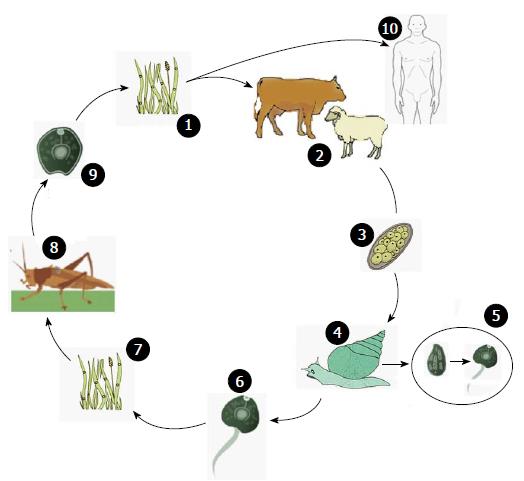Copyright
©The Author(s) 2015.
World J Exp Med. Aug 20, 2015; 5(3): 160-163
Published online Aug 20, 2015. doi: 10.5493/wjem.v5.i3.160
Published online Aug 20, 2015. doi: 10.5493/wjem.v5.i3.160
Figure 1 Eurytrema spp.
life cycle. 1: Infection by grazing on infected grass; 2: Vertebrate host (cow or sheep); 3: Unembryonated eggs released in feces; 4: Ingestion of eggs by Bradybaena sp.; 5: Sporocyst mother in sporocyst son in the digestive tube between 90 and 350 d, according to envionmental conditions. Sporocyst sons containing cercarea are released in the environment few hours before dawn; 6: Cercarea released in the environment; 7: Ingestion of cercarea by Conocephalus sp.; 8: Development of infective metacercarea inside grasshopper; 9: Infective metacercarea released in the environment; 10: Possible human infection by consumption of infected salad. One egg of Eurytrema spp. produces 100 sporocyst sons which turn into 200 cercareas and latter 20000 infective metacercarea. Adapted from Tessele, CDC and Bennett[6,15,16]. CDC: Centers for Disease Control and Prevention.
- Citation: Schwertz CI, Lucca NJ, Silva ASD, Baska P, Bonetto G, Gabriel ME, Centofanti F, Mendes RE. Eurytrematosis: An emerging and neglected disease in South Brazil. World J Exp Med 2015; 5(3): 160-163
- URL: https://www.wjgnet.com/2220-315X/full/v5/i3/160.htm
- DOI: https://dx.doi.org/10.5493/wjem.v5.i3.160









